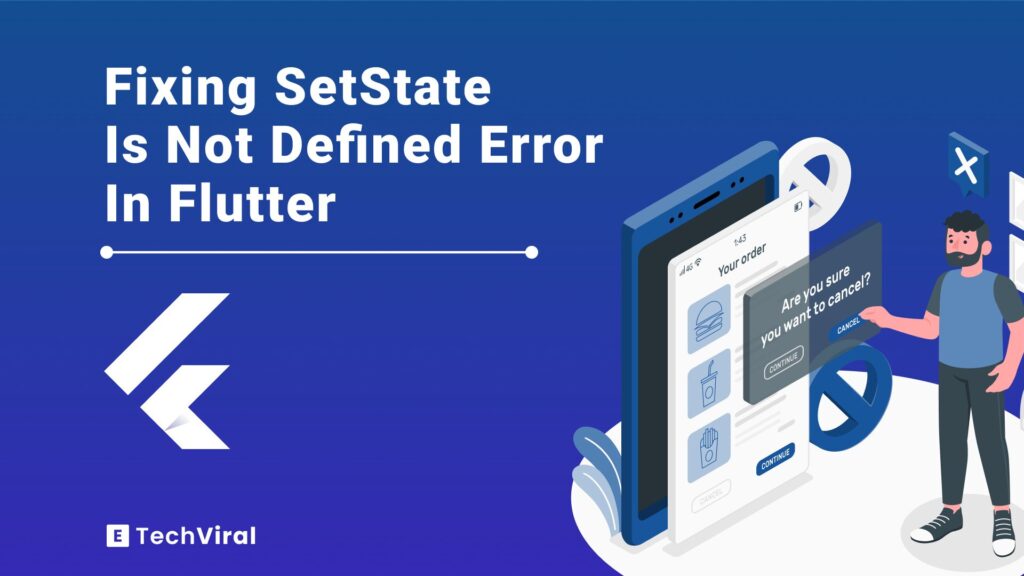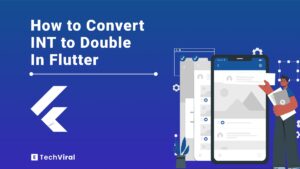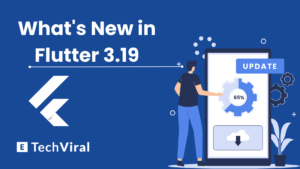Flutter is a good tool, But even the best tools can give you a headache, like when setState doesn’t work right. This setState error can really slow you down when you’re building your app. Think of setState as a magic spell in Flutter that makes sure your app’s look is up-to-date. When it’s missing or messed up, your app might not listen to you the way it should. We’re here to fix setState isn’t defined error in Flutter together, making Flutter development a breeze and error fixing less of a chore.
What is setState in Flutter?
Ever wondered how Flutter apps stay so lively and responsive? It’s all thanks to setState, a real game-changer. setState tells your app to freshen up, showing any new changes. Imagine you’re playing a game where the score updates every time you score a point. That update? That’s setState working its magic.
Let’s dive into a code example. Say you have a scorekeeper app. You press a button, and the score goes up. Here’s a peek at how it might look:
void _increaseScore() {
setState(() {
_score++;
});
}
In this snippet, setState wraps around the part where the score (_score) gets a boost. It’s like telling the app, “Hey, something changed! Show the new score, will you?” And just like that, your app knows to display the updated score, thanks to widget re-rendering.
Speaking of keeping your app’s look up-to-date, mastering the date format in Flutter is another skill that enhances your app’s user experience by ensuring that date and time are displayed correctly and intuitively.
This magic happens inside your app’s Build method, a special spot where Flutter draws the app’s look. Every time setState is called, it triggers the Build method again, making sure your app’s appearance is always up to date. So, whether it’s a simple scorekeeper or a complex social media app, setState keeps everything in check, ensuring your MyApp stays as dynamic as the world around us.
Why does the error Flutter setState isn’t defined occur?
Running into the ‘Flutter setState isn’t defined’ error can feel like hitting a brick wall during your app-building journey. But don’t worry, it’s a common hiccup that many developers face. Let’s break down why this happens and how you can steer clear of it in the future.
First off, this error often pops up when setState is used in the wrong place. Imagine you’re trying to update your app’s look based on new data, but you’re doing it outside of a StatefulWidget. That’s a no-go. Flutter needs setState to be inside a StatefulWidget to work its magic properly.
Another usual suspect is the incorrect use of setState in asynchronous operations. Here’s a quick look at what not to do:
Future<void> _fetchData() async {
var newData = await someAsyncOperation();
setState(() {
_data = newData;
});
}
If you call setState before your data is ready, Flutter might tell you it’s not sure what you’re trying to do.
Lastly, simple syntax errors or not following the Flutter package import rules can lead to trouble. Maybe you forgot to import the necessary Material library or made a typo in your code. These small mistakes can cause big headaches.
How Can You Fix SetState isn’t Defined Error in Flutter?
Stumbling upon the ‘Flutter setState isn’t defined’ error can be a real head-scratcher, but fear not! With a few tweaks and a bit of know-how, you’ll have your Flutter app back on track in no time. Let’s dive into some foolproof strategies to kick this error to the curb.First things first, double-check that you’re working within a StatefulWidget context.
Flutter’s setState function is like a secret handshake that only works within the exclusive StatefulWidget club. If you find yourself outside, you’ll need to switch clubs. Converting a StatelessWidget to a StatefulWidget is simpler than it sounds:
class MyWidget extends StatefulWidget {
@override
_MyWidgetState createState() => _MyWidgetState();
}
class _MyWidgetState extends State<MyWidget> {
// Your code goes here
}
This code snippet is your golden ticket into the StatefulWidget party, where setState calls are the main event.
Next up, mastering the art of setState in asynchronous operations is crucial. Flutter loves to keep things snappy, so ensuring your setState calls happen at just the right time is key. Here’s a pro tip: wrap your setState inside the then callback of your asynchronous operation to ensure it waits patiently for the right moment:
Future<void> fetchData() async {
someAsyncOperation().then((newData) {
setState(() {
_data = newData;
});
});
}
This approach guarantees that setState only does its thing once the data is ready, keeping both Flutter and your app happy.
But what if you’ve done all this and still face the dreaded error? Time to play detective and hunt down those pesky syntax errors. Even the best of us miss a comma or misplace a bracket from time to time. Leveraging the power of your IDE and the Flutter SDK can help you catch these errors before they catch you off guard. These tools are like having a super-smart buddy who points out where you went wrong, helping you fix issues in a jiffy.
In addition to fixing setState errors, understanding how to implement a Flutter AlertDialog and text center alignment in Flutter can significantly improve user interaction by providing timely feedback or confirming user actions, which is crucial for a polished app experience.
Flutter setState isn’t Defined Alternate Fixes
First up, make sure you’ve imported the Flutter package correctly at the top of your file. It’s easy to overlook, but without it, your app won’t know how to handle setState or anything else Flutter-related. A simple line like this at the beginning of your Dart file can make all the difference:
import 'package:flutter/material.dart';
Next, take a moment to double-check the context in which you’re calling setState. Flutter can be picky about where and how its functions are used, so ensuring you’re in the right place is key.
Also, give your variable names another look. A typo here can lead to all sorts of confusion, not just for you but for Flutter as well. It’s like calling out a friend’s name in a crowded room; if you get it wrong, don’t expect a response.
Don’t forget to check for any missing dependencies in your pubspec.yaml file. Flutter apps rely on a symphony of packages working together, and if one is missing, it can throw off the whole performance.
Lastly, when all else fails, a good old-fashioned clean and rebuild of your project can work wonders. Run these commands in your terminal:
flutter clean flutter pub get
This is like giving your app a fresh start, clearing out any cobwebs and making sure everything’s in its right place.
Also Read:
How Can You Analyze SetState Isn’t Defined Error
First off, the IDE you’re using is more than just a place to write code; it’s your first line of defense against bugs. Most IDEs compatible with Flutter have built-in debugging tools that highlight errors in real time, guiding you directly to the source of the problem. This immediate feedback is invaluable for quickly identifying issues like our notorious ‘setState isn’t defined’ error.
Another ace up your sleeve is the Flutter command line tool. Running flutter analyze in your project directory will scour your code for issues and report back with any findings. This can often reveal hidden problems that weren’t immediately obvious.
Lastly, don’t underestimate the power of logging. Adding print statements before and after your setState calls can help you understand the flow of your app and pinpoint exactly where things are going awry.
Conclusion
Fixing the setState isn’t defined error in Flutter boils down to a few key moves. Ensure you’re in the right context, keep an eye on syntax, and don’t shy away from Flutter’s debugging tools. But don’t stop here. Diving deeper into Flutter development and mastering state management will not only fix this issue but also boost your app’s performance. So, keep exploring, keep learning, and let Flutter and setState work their magic for you.
FAQ’s
Can I use setState in StatelessWidget in Flutter?
No, you cannot directly use setState in a StatelessWidget because it lacks the state object needed to update the UI. StatelessWidget is immutable, meaning its properties can’t change during runtime. To update the UI dynamically, consider converting your StatelessWidget to a StatefulWidget, which supports dynamic content through state management.
What happens if I call setState too often?
Calling setState too often can lead to performance issues in your Flutter app. Each call to setState triggers the build method, leading to widget re-rendering. If done excessively, this can cause your app to become sluggish and unresponsive. It’s crucial to use setState judiciously to maintain smooth app performance.
Can setState update multiple variables at once?
Yes, setState can update multiple variables at once. When you call setState, you can include multiple variable updates within the single call. This is efficient and ensures that the widget is only rebuilt once, even if you’re updating several aspects of the widget’s state.
Is there an alternative to using setState in Flutter?
Yes, Flutter offers several state management alternatives to setState, such as Provider, Riverpod, Bloc, and MobX. These tools offer more scalable and organized ways to manage state, especially in larger applications. They help in separating business logic from UI code, making your codebase cleaner and easier to maintain.
How do I know if setState is causing performance issues?
If your Flutter app is experiencing lag or slow UI updates, setState might be causing performance issues. Profiling your app with Flutter’s performance tools can help identify if setState calls are too frequent or if they’re triggering unnecessary widget rebuilds. Monitoring frame rendering times is a good indicator of performance bottlenecks.











